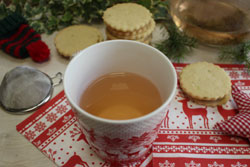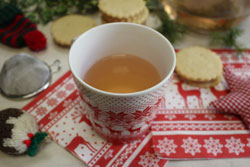It’s Christmas in a Cup!

It’s quite a surprise to learn your Christmas tree is an edible herb: who knew? It turns out familiar pine nuts aren’t the only edible part of pine trees.
Citrus-flavoured pine needles make the most delicious tea and can be used as a herb to flavour food.
Refreshing, with just a hint of orange, pine needle tea tastes very like regular tea. It contains a range of beneficial nutrients including antioxidants and vitamin C. It’s also mildly antiseptic and acts as a decongestant and expectorant.
Pour 300ml (1 pint) just boiled water over 3 teaspoons lightly packed bruised pine needles in a warmed tea pot.
Steep for 10 minutes. Strain and serve.

Pine Needle Notes
Harvest tender new growth tips from the last 2-3cm of the twigs only. Use as you would any woody herb such as rosemary or thyme: add sprigs to cooking or strip off leaves and chop finely.
Only ever pick from garden-grown trees. Commercial Christmas trees aren’t grown to food-grade standards and may have been recently treated with pesticides and herbicides.
Most pine, fir and spruce spices are edible, notable exceptions are the Ponderosa pine and the Norfolk Island Pine Araucaria heterophylla). Do NOT try to eat these!
The Norway Spruce Picea abies is always reliable and has a good flavour.
NEVER eat spiky needle-like leaves from ANY OTHER CONIFER: some, such as yew, are highly toxic.